Both the Federal Reserve’s and foreign central banks’ appetite for US Treasury debt have apparently been sated, (for now anyway) as seen below.The Federal Reserve alone has increased its reserves of US Treasury debt by 850% since 2008. Its three binges of quantitative easing are clearly visible (red plot). Foreign-central banks too have been gluttons consuming massive quantities of US Treasuries up until their demand peaked in November 2012. They then upchucked some $421 billion dollars of them in a single week. Since then however,these central bank holdings of US Treasuries have held steady at around $3.25 trillion dollars.
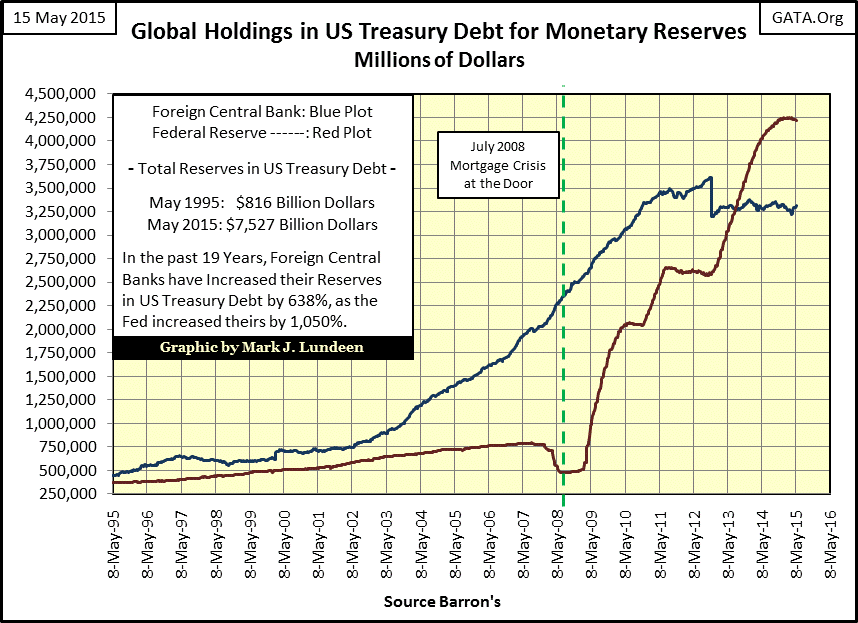
Below we see the same data above as a percentage of the US national debt. Note the differences in the plots above and below. Although foreign central bank holdings have remained steady at $3.25 trillion since November 2012 (above), their multi-trillion dollar holdings of Uncle Sam’s IOU shave actually decreased from 25% of the US national debt in July 2008 to only 17.5% in May 2015.
The best way to understand these plots is to realize that when they are rising foreign-central banks (or the Federal Reserve) are monetizing Treasury debt faster than Congress is bankrupting the United States. When they are declining then Congress is bankrupting the United States faster than foreign-central banks, (or the Fed) are monetizing Treasury debt.

What is “debt monetization”? That is what happens when the US Treasury needs to pay for expenses above and beyond what can be covered by tax revenues alone. So the US Treasury prints up some bonds and the Federal Reserve pays for those bonds with a check drawn on an account with a zero balance. Voila! Money is created from nothing!
But the debt it leaves behind still needs to be serviced and the US Treasury is obligated to pay interest on those bonds to the Federal Reserve. Ideally, those freshly created US Treasury debt instruments are intended to be sold into the open market by the Federal Reserve, but currently the Fed needs to maintain a policy of purchasing US Treasury debt on the open market (quantitative easing) which makes that impossible. So the Federal Reserve’s balance sheet is becoming bloated by continually absorbing this US Treasury debt from the market, and since 2008 has also been absorbing mortgage debt as the value of mortgage backed securities continually climb in order to suppress mortgage interest rates. (This seems to have reversed in recent weeks.) Without this emergency support, the US real estate market would currently be in far worse shape.
This artificial suppression of interest rates is also necessary to prevent the insolvency of the US government itself. It could not afford to pay a higher rate to borrow, and must continue to borrow just to continue functioning. And as government continually expands, just the cost of its functioning will drain the rest of the economy dry.
In May of 1995 central banks’(including the Federal Reserve) holdings in the US Treasury market were only about 16% of the then$4.85 trillion dollar US national debt, butt hat all changed when Greenspan’s bubbles went bust. First foreign central banks increased their holdings of Treasury debt by 18% during a nine week period during the 2000-2002 Tech Wreck. Most American’s are still unaware that the Euro Zone also experienced a devastating bubble in their real estate market at the same time as the American real estate bubble. The blue plots above illustrate where much of the credit for Europe’s mortgage bubble came from:monetizing US Treasury debt.
As a percentageforeign CB’s holding of the US national debt peaked at 25% in July 2008 just as the Euro Zone’s mortgage market began to crater. Here are two YouTube videos from a few years ago on the aftermath of the Spanish real estate bust. The first is a three minute report from the Associated Press, the second a twenty-six minute report from the Wall Street Journal.
The WSJ report shows just how clueless people are when it comes to understanding exactly what happened in Spain. So what did happen? When the US took the global financial system off the gold standard in August 1971, this allowed central banks to create credit by monetizing government debt. The banking system then“injected” the property markets with grotesque levels of cheap credit, which financed construction far beyond market demand, as prices increased until they first became prohibitive, and then self-destructive to society until the bubble ultimately popped. As with all credit financed manias,mountains of toxic-financial waste devastated lives and bewildered “market experts” follow in their aftermaths.
The pathology of unchecked sovereign debt monetization now appears to be metastasizing in the sovereign bond markets themselves. As apparent in the red plots above, the Federal Reserve’s QE programs have ceased (for now), but the full impact of the artificial demand for Treasury debt created by quantitative easing and the vacuum now created from its cancellation are best illustrated in the chart below.
During the high-tech bubble’s blow-off, and incredibly during the entire period of the mortgage bubble (2001-07), the Federal Reserve monetized just $2.98 billion dollars of Treasury debt per month. Then, when Bear Stearns and other influential NY banks’ portfolio of sub-prime mortgage “assets” became undeniably toxic in 2008, the Federal Reserve began swapping their US Treasury monetary reserves for Wall Street’s garbage mortgages (down spike in box). Since2008 the Fed has been monetizing US Treasury debt at the average rate of$50 billion a month.
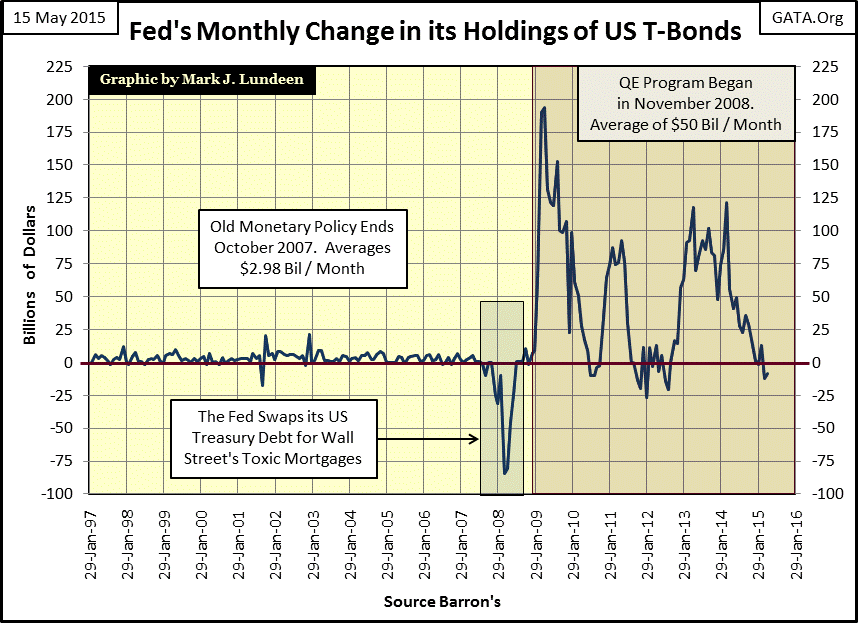
The monetary data above is never discussed within earshot of the general public, or on CNBC. Whenever it is discussed in academia it’s with a cold clinical tone so as not to hint at the criminality of the Federal Reserve. The entire national debt was only $2.9 billion (yes billion) dollars when the Federal Reserve was first created by act of Congress in 1913, the same amount Alan Greenspan monetized monthly during the period from 1997 to 2007.
Currently the FOMC isn’t monetizing any of the national debt. Since early February of this year this lack of demand appears to be having an effect on the Treasury market. Below is a chart of a now well-seasoned 30 Yr. T-Bond whose weekly closing price and yield I’ve been tracking since it was issued in August 1997. This bond’s yield has increased by 44 basis points in the past fifteen weeks (red box). However on Monday of this week this bond closed with its yield up 57 basis points since February, but managed to recover to unchanged for the week by Friday’s close. If you look closely, you’ll see two little dots in the red box for the price and yield plots to indicate how this bond would have closed had Monday’s values stood for the week.
The point is that ever since the Fed terminated QE in late 2014, the three decade long bull market in Treasury debt has stalled.
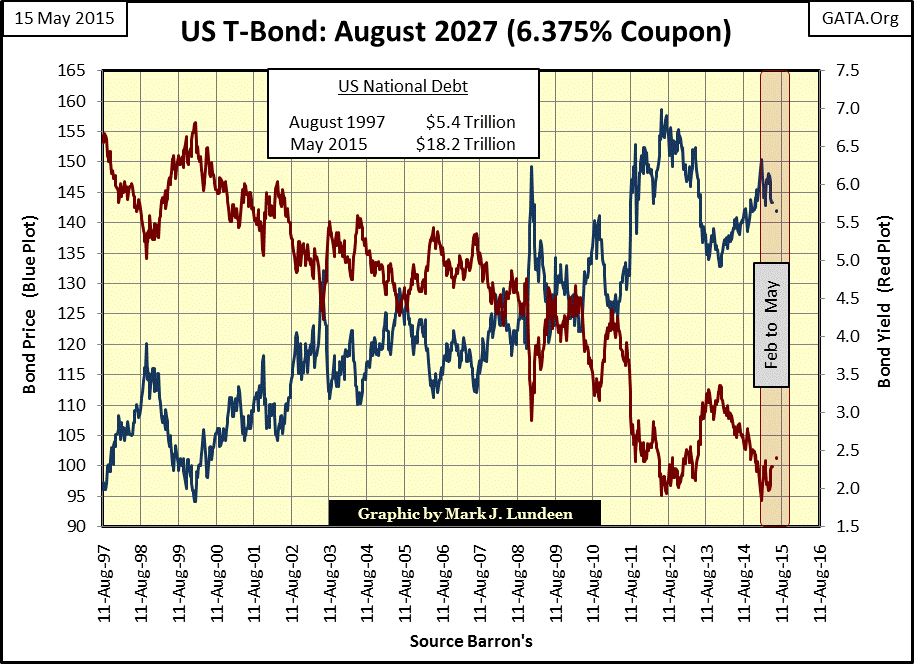
Seeing how a U.S. 30-Year T-bill matures over the decades is interesting. However after eighteen years this bond is now behaving more like a U.S. 10-Year bond than a 30Yr T-bond. So, I also plotted the yield for the longest dated T-Bond below. Since early February the actual 30Yr T-bond has seen its yield jump by 68 basis points, at week’s close yielding 2.93%. But by Monday’s close it was yielding 3.03%, a one day gain of 13 basis points from last Friday’s close. As above, I have included a dot to show where the yield closed on Monday.
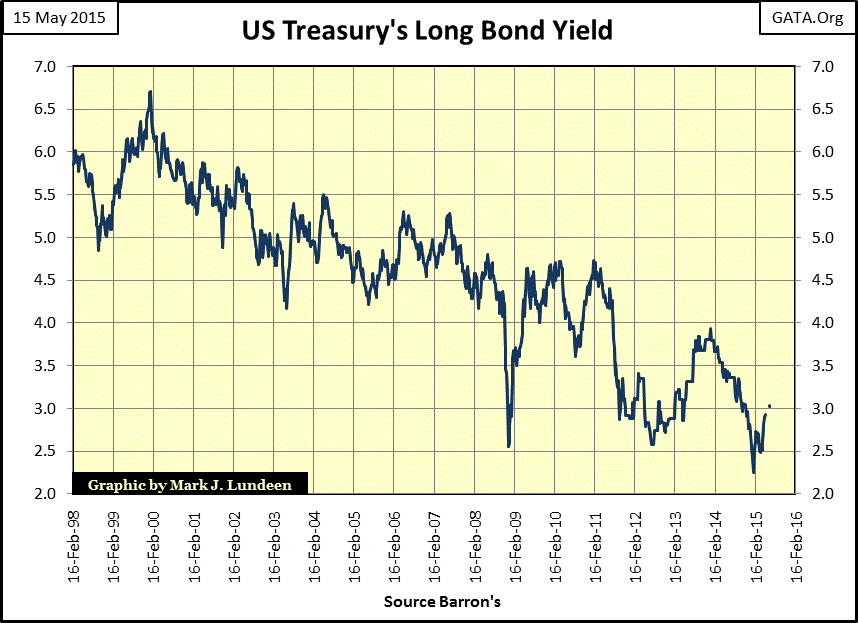
If this trend of rising yields continues, the response by the idiot-savants managing “monetary policy” at the Federal Reserve will be interesting. Will the Fed stand clear and allow the bond market’s natural market forces to determine prices and yields in the T-bond market? NOT LIKELY! When the 30Yr bond’s yield approaches its levels of February 2011(4.50%),(or maybe just 3.90% last seen in January 2014),I expect a fourth round of QE for the simple reason that the US government won’t be able to service the additional interest burden on its $18.15 trillion dollars of existing debt as current debt instruments continually come due and must be rolled over at higher rates. This problem will be exacerbated by the increased weighting of short term and very short term US Treasury debt on the Fed’s balance sheet (thanks to Operation Twist).
Europe too, is having problems with sovereign debt, problems that began in 1993 with the establishment of the Maastricht Treaty’s economic requirements. The goals were good, but unfortunately countries like Greece and Italy achieved them with help of OTC derivatives sold to them by Wall Street hucksters back in the 1990s. At the time these quick fixes seemed to work for Italy. At least its bond yields improved from junk to investment grade between 1995 and 99 (Blue Plot below), if not Italy’s actual credit quality. For the EU’s “policy makers” in Brussels, seeing the bond market show its approval of member nations’ fiscal affairs was sufficient to justify inflicting the euro on an unsuspecting world.
Back in the early years of the 21stcentury it was exciting to ponder the possibilities of the European Union, which miraculously made it possible for little Greece to issue bonds as strong as Germany’s.In fact, ten years ago everyone believed that Germany would be the guarantor of the euro; but that was ten years ago.
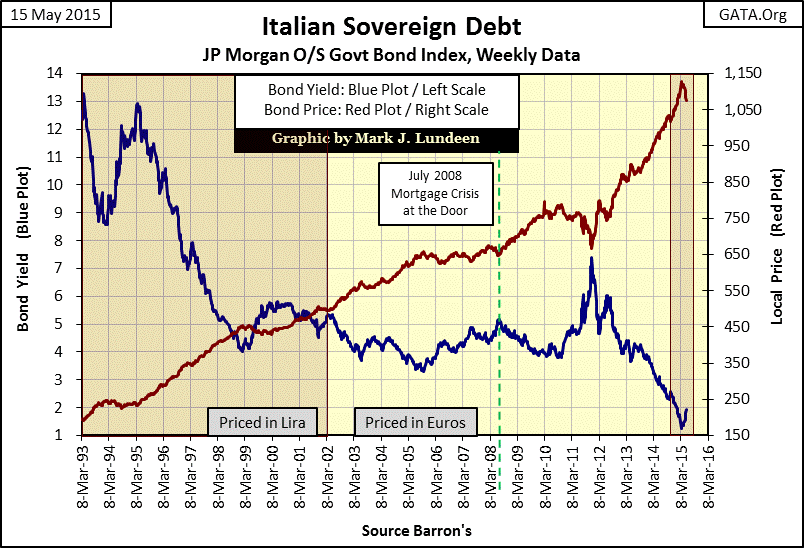
Above and below we see two examples of European sovereign debt; Italian and German. We live in a world where it’s become impossible for the aged and infirm to find a safe source of income. That’s because central banks are continually monetizing their country’s national debt, purchasing sovereign bonds at prices far above their fair market value in a vain effort to save their country’s banking systems and politicians’ careers. Look how far government bond yields have declined over the past twenty-two years; US T-debt yields as well.For the past few weeks, however, Italian and German (and many others) bonds yields have reversed and started climbing. Obviously Europe’s central banks have also stopped monetizing their sovereign debt, at least for now.

People blessed with just a little prudence and historical perspective are beginning to understand that ultimately,the only solution to the fiscal and monetary problems currently plaguing both Europe and the United States is to default on their debts and walk away from their currencies. Most people don’t want to even consider this a possibility, but history is full of examples of governments doing exactly this under similar circumstances. It goes without saying that today our “policy makers” would execute such an operation in a manner to ensure the survival of their precious-banking systems, if not their aged and infirm whose savings they’ve been looting for years.
The price of gold and US long bond yields will prove useful in determining how close that fateful day of destiny is to our door. As evident below, the 1969-80 gold bull market thrived during a time of sharply rising bond yields, which is quite logical as bond holders were fleeing the bond market with its then double-digit losses to principal and buying non-interest bearing gold to preserve capital.
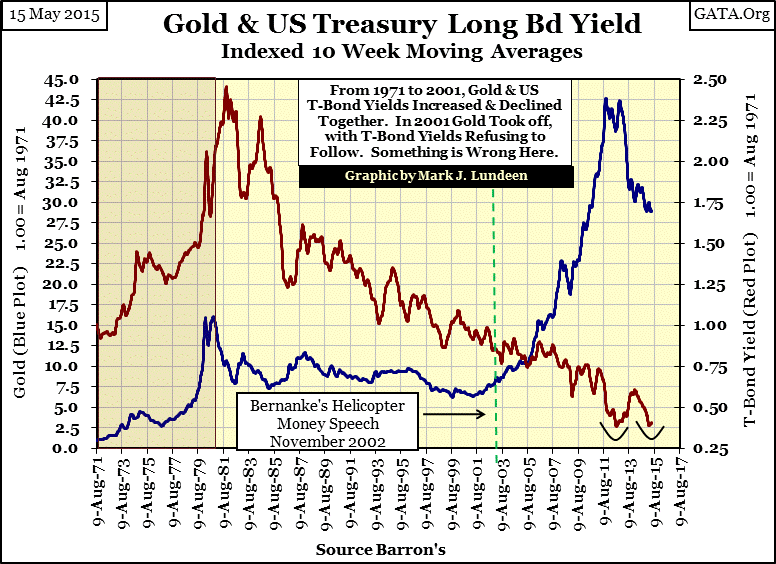
The 1980-2001 gold bear market occurred during a twenty-year bull market in bonds, which is also logicalas former gold bulls sold their gold to purchase bonds for income as CPI inflation once again became tame. But something strange happened in 2001. The thirty year trends in the price of gold and long bond yield diverged for the first time since 1971; for ten years both non-interest bearing gold andbonds enjoyed a bull market concurrently, and that’s just not logical – or is it?
To understand what’s happening above one has to remember that back in 2001 deflation (the hobgoblin of “policy”) was running a'muck in the stock market as the high-tech bubble deflated. What’s a “policy maker” to do? Doctor B.S. Bernanke, America’s foremost expert on “policy errors” during the Great Depression had the answer.
“Like gold, dollars have value only to the extent that they are strictly limited in supply. But the U.S. government has a technology, called a printing press (or, today, its electronic equivalent), that allows it to produce as many U.S. dollars as it wishes at essentially no cost.By increasing the number of U.S. dollars in circulation, or even by credibly threatening to do so, the U.S. government can also reduce the value of a dollar in terms of goods and services. We conclude that, under a paper-money system, a determined government can always generate higher spending and hence positive inflation. Of course, the U.S. government is not going to print money and distribute it willy-nilly……..”
- Ben S. Bernanke, Federal Reserve Board Governor, New York Economic Club November 21, 2002.
Cutting to the chase, in 2002 Doctor Bernanke recommended to his fellow “policy makers” that the solution to deflation in the stock market, or anywhere else, was one that “policy makers” in the 1930s rejected: just keep on printing money until the deflating financial market is reflated. Small wonder the Doctor became Alan Greenspan’s replacement, and the darling of Wall Street. But not everyone was buying that line-of-malarkey, as evident in the chart above where the 2001-2015 gold bull market began as the bull market in bonds continued on into its forth decade.
So sadly, this too is logical. Returning to this article’s first two charts, we see the full extent of the central bank patronage the US Treasury market has enjoyed since Bernanke’s 2002 speech. How could bond prices possibly fall and yields rise when official-sector presence in the T-debt market has increased from 16% to 42% since 1995? And in a world where Federal Reserve officials have made verbal public commitments to “reduce the value of a dollar in terms of goods and services” as was done in November 2002, should we not expecthighergold and silver prices?
The post August 2011 correction in precious metals is more an annoyance than a problem. As kryptonite is to Superman, gold is to a Keynesian-central banker; so it’s safe to assume that just as much effort was put into containing the gold market since 2011 as was used in keeping the US Treasury market on its bullish trajectory. However, all things considered, (such as the indexed performance of precious metals and financial assets since January 2000 below), gold and silver are still the best performing asset since 2011 despite all their woes. Incredibly silver, even at the bottom of a 67% correction has still managed to outperform dividend paying blue-chip stocks (Dow Jones / Blue Plot below) by better than 100% since 2000.
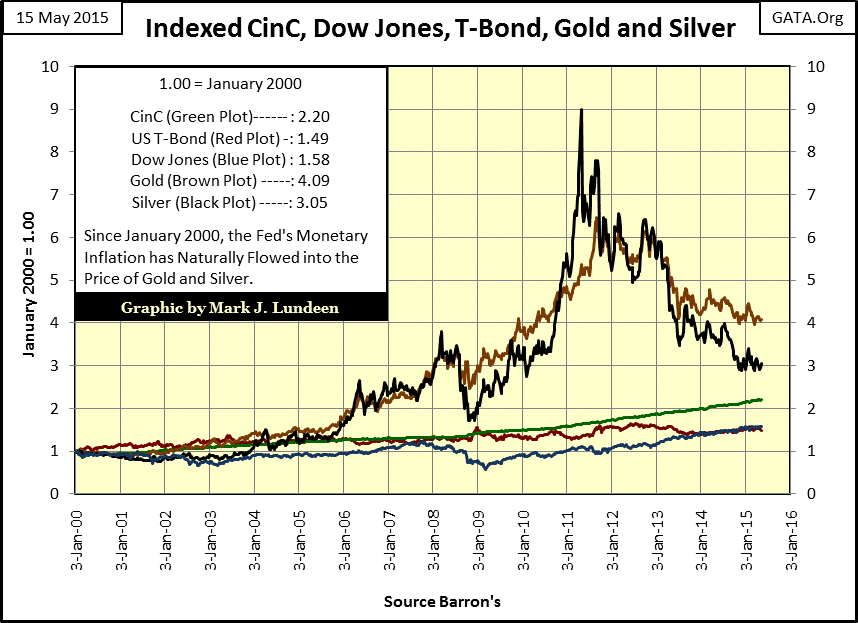
Since 2000 the global central banking system has monetized too much sovereign debt for its own good. Their ability to enforce “policy” on the global markets is just not what it used to be. When trends in precious metals and bond yields once again begin to synchronize to the upside enthusiastically, it will be a sure sign that natural market forces, after a stay of many decades, are once again in control. Expect to see chaotic market moves as the market fixes put in place by central banks come undone. That means precious metals and their miners can look forward to a bull market of historic proportions.
